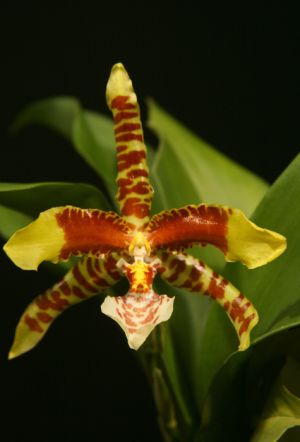No edit summary |
No edit summary Tag: wikieditor |
||
| Line 12: | Line 12: | ||
The easiest way to identify this species is when the lip can be viewed well is the yellow, flabellate, pubescent, suborbicular column wings instead of the thin, elongate, recurved, reddish column wings instead of the rare R williamsianum. Of course there are many other differences including a fewer flowered, shorter inflorescence but the column wings are diagnostic. | The easiest way to identify this species is when the lip can be viewed well is the yellow, flabellate, pubescent, suborbicular column wings instead of the thin, elongate, recurved, reddish column wings instead of the rare R williamsianum. Of course there are many other differences including a fewer flowered, shorter inflorescence but the column wings are diagnostic. | ||
Latest revision as of 16:01, 11 June 2024

Common Name: The Large Rossioglossum, The Clown Orchid
Scented: no
Light Requirements: partial shade
Temperature Requirements: cold to intermediate
Blooms: late autumn to winter
Flower Size: to more than 15cm
Synonyms: *Odontoglossum grande Lindl.1840; Rossioglossum grande var. aureum (Stein) Garay & G.C.Kenn. 1976
Found from Guatemala, Belize and Mexico as a medium to large sized, epiphytic, warm to cold growing orchid that occurs at elevations of 1400m to 2700m in moist deciduous, rainforests with a distinct wet, shady [from leaves] spring and summer and much drier and brighter [fallen leaves] autumn and winter, with clustered, ovoid or orbicular, laterally compressed, ancipitous, glaucous, pseudobulbs carrying 1 to 3 apical, elliptic or lanceolate, coriaceous, glaucous, acute, petiolate leaves and blooms on an axillary, lateral to erect, to 30cm long, racemose, several [2 to 8] flowered inflorescence with lanceolate, apressed, scarious bracts and waxy long lasting flowers all occurring in late autumn and winter.
The easiest way to identify this species is when the lip can be viewed well is the yellow, flabellate, pubescent, suborbicular column wings instead of the thin, elongate, recurved, reddish column wings instead of the rare R williamsianum. Of course there are many other differences including a fewer flowered, shorter inflorescence but the column wings are diagnostic.